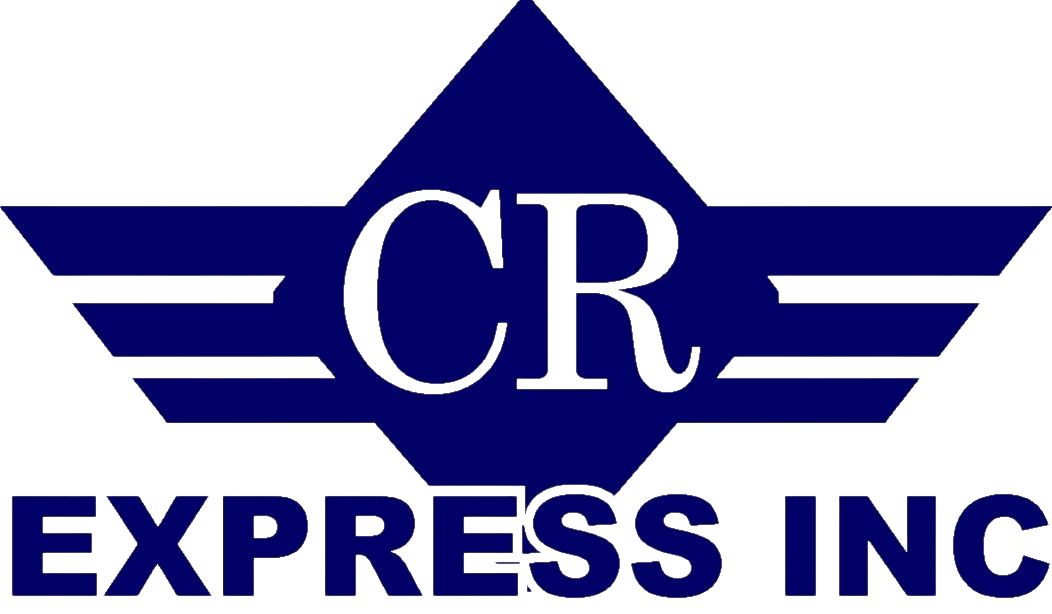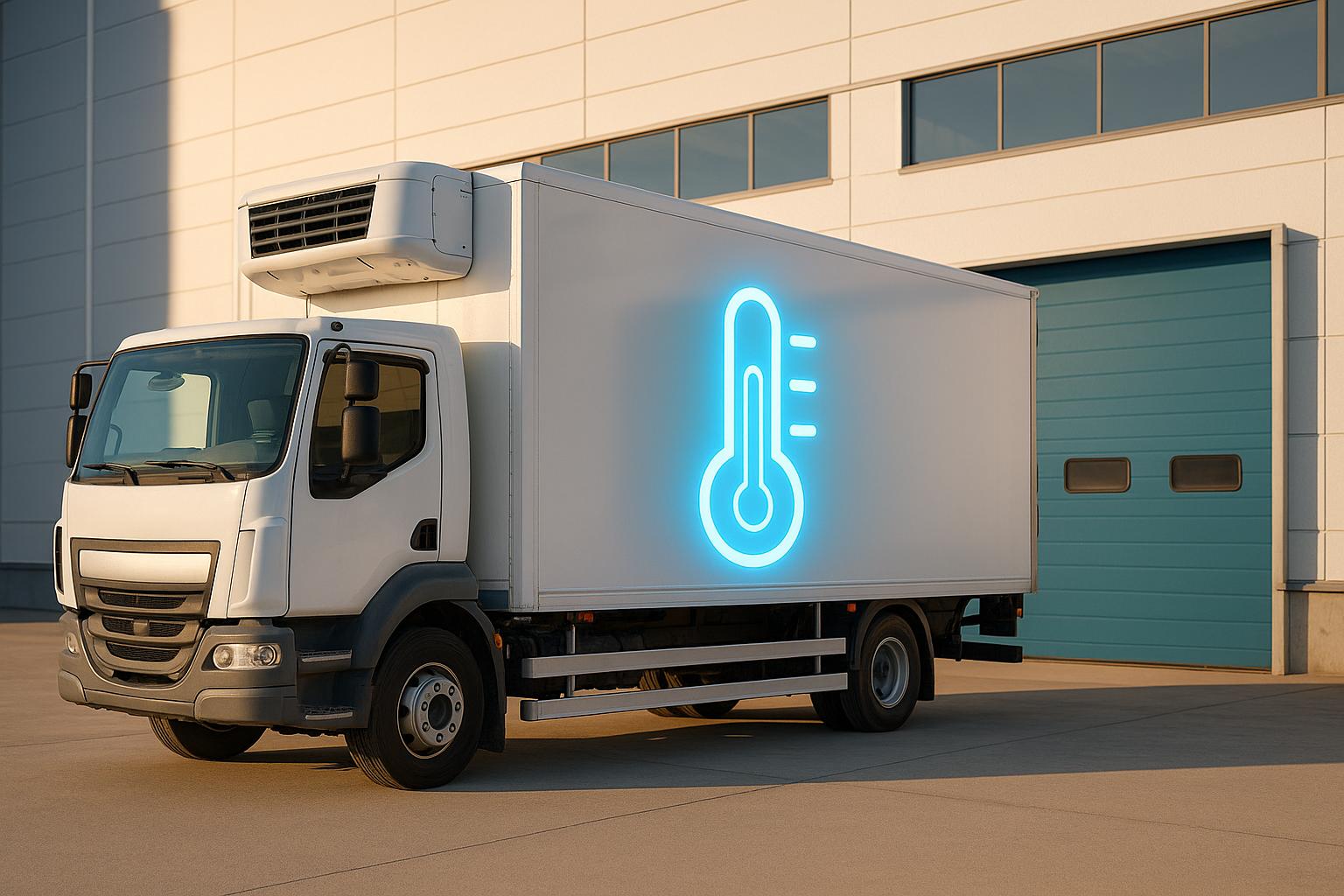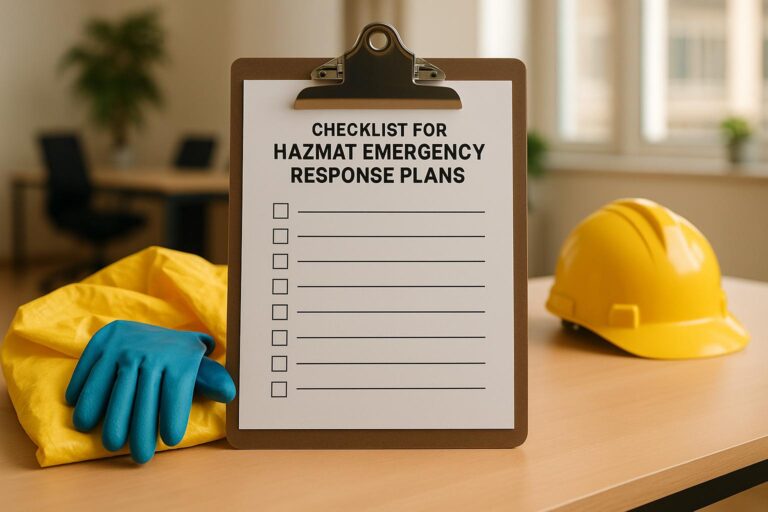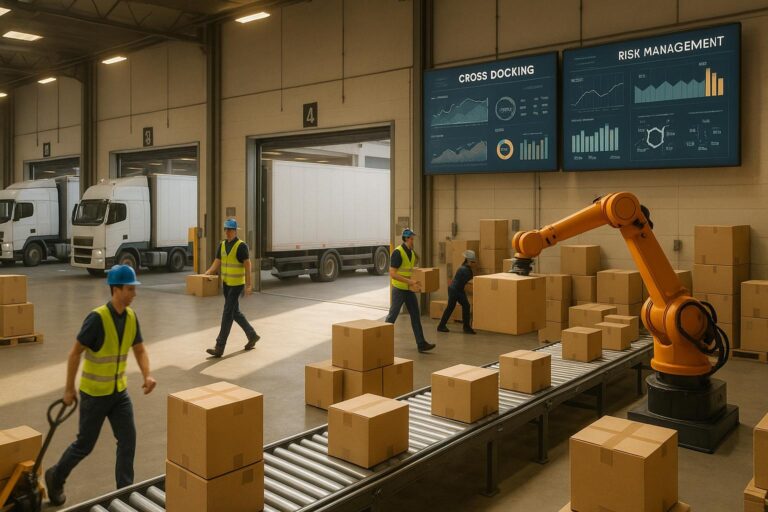The cold chain is the backbone of industries like pharmaceuticals, food, and chemicals, ensuring temperature-sensitive products remain safe and effective from production to delivery. But maintaining this system is challenging – equipment failures, human errors, and transit delays can result in spoilage, financial losses, and regulatory penalties.
Here’s what you need to know:
- Cold Chain Risks: Temperature excursions, equipment malfunctions, transit delays, and human errors are common threats.
- Industries Affected: Healthcare, food, and chemicals heavily rely on cold chain logistics to meet strict safety and quality standards.
- Risk Management: Identify vulnerabilities through audits, use real-time monitoring, and create contingency plans like backup routes and emergency protocols.
- Regulatory Compliance: Adhere to FDA, USDA, and GDP guidelines, ensuring proper documentation, calibrated equipment, and traceability.
- Technology Solutions: IoT sensors, GPS trackers, and automated systems provide real-time data to prevent losses and improve operations.
- Expert Support: Partnering with specialized logistics providers can simplify operations, ensure compliance, and safeguard product quality.
To stay ahead, focus on proactive risk management, invest in monitoring technology, and collaborate with experienced logistics partners.
Risk Mitigation Strategies
Cold Chain Risk Assessment and Analysis
Effective risk assessment is essential for running a successful cold chain operation. Without a structured way to identify and evaluate potential threats, businesses risk disruptions that can compromise product quality, lead to financial losses, and harm their reputation.
How to Identify Cold Chain Risks
Start by mapping out all potential risks – ranging from temperature deviations to equipment malfunctions – throughout the entire supply chain. For instance, temperature excursions occur when products are exposed to temperatures outside their required range during storage or transit. These deviations can happen quickly and may result in irreparable damage to sensitive items like pharmaceuticals, vaccines, or fresh produce.
Another significant risk is equipment failure. Refrigeration units can break down unexpectedly, backup generators may not function during power outages, and temperature monitoring devices might provide inaccurate data. Take, for example, a refrigerated truck carrying high-value biologics – if its compressor fails, the entire shipment could be ruined in just a few hours.
Transit delays are another common issue with far-reaching consequences. Delays caused by weather, traffic accidents, customs inspections, or mechanical failures can push shipping times beyond safe limits. Even a short delay can lead to product loss if the shipment exceeds its temperature stability window.
Human error also plays a major role in cold chain breakdowns. Mistakes like loading goods into non-refrigerated vehicles, setting incorrect temperature levels, or mishandling products can jeopardize the entire operation.
External factors such as natural disasters can wreak havoc on cold chain logistics. In 2021, one U.S. food supplier used weather forecasting to anticipate a hurricane, rerouting deliveries to prevent spoilage and maintain customer satisfaction.
To tackle these challenges, companies often use risk registers to document potential issues at each supply chain stage. Regular vulnerability assessments and scenario planning exercises can also enhance preparedness for unexpected disruptions.
Finding Weak Points in Your Supply Chain
Identifying vulnerabilities in your cold chain requires a detailed review of your infrastructure, processes, and partnerships. For example, outdated refrigeration equipment is a common weak point. Older systems often lack modern monitoring features and are more likely to fail during periods of high demand.
Relying on a single supplier for temperature-controlled services can also pose risks. In 2022, a major car manufacturer reduced delays by 40% by sourcing key components from multiple suppliers. The same strategy applies to cold chain logistics – depending on just one refrigerated carrier or storage facility leaves you exposed if something goes wrong.
Infrastructure audits can uncover hidden issues that might not be apparent during daily operations. These reviews should include maintenance records for refrigeration units, the condition of temperature monitoring devices, and the reliability of backup power systems. Other factors to evaluate include insulation quality, loading dock coverage, and seasonal capacity.
Assessing the reliability of your suppliers is equally important. Look at historical performance data, such as on-time delivery rates, temperature excursion incidents, and adherence to handling protocols. Key metrics like average temperature deviations and equipment downtime provide measurable benchmarks to evaluate supplier performance.
Geographic risks also deserve attention. Routes passing through areas prone to severe weather, high crime, or limited backup services increase exposure to potential disruptions. Mapping these high-risk zones is a crucial step in planning alternative routes and mitigating risks.
Setting Risk Management Priorities
Not all risks require the same level of attention or resources. Use a combination of qualitative insights and quantitative models to prioritize risks based on their likelihood and potential impact. This ensures that high-probability, high-impact events receive immediate focus.
| Assessment Method | Best Use Case | Key Benefits |
|---|---|---|
| Qualitative | When hard data is scarce | Leverages expert insights and identifies emerging risks |
| Quantitative | For operations with extensive data | Provides clear, measurable risk rankings |
When assessing impact, consider more than just product loss. Factor in regulatory penalties and long-term damage to your brand’s reputation. Regulatory consequences might include license suspensions or mandatory recalls, which can amplify the fallout from an incident. For example, a single cold chain failure – such as contaminated food reaching consumers – can erode years of customer trust. In industries like pharmaceuticals, even minor temperature deviations can cast doubt on a company’s entire quality assurance process.
Risk prioritization must also align with regulatory requirements. For example, the FDA’s guidelines for pharmaceutical cold chain management and the USDA’s standards for food transportation often take precedence over purely financial considerations. Failing to meet these standards can lead to severe consequences, such as product seizures or the loss of operating licenses.
For complex supply chains, creating a risk priority matrix – plotting the likelihood of an event against its impact – can help decision-makers quickly identify which threats need immediate action and which can be monitored over time.
Regulatory Requirements and Industry Standards
Navigating federal regulations is a cornerstone of maintaining product quality and safeguarding public health in temperature-controlled logistics. These regulations aren’t just red tape – they’re essential for ensuring safety and integrity throughout the supply chain.
Key U.S. Regulations
The Food Safety Modernization Act (FSMA), enforced by the FDA, lays the groundwork for food safety in temperature-sensitive logistics. FSMA mandates that shippers, carriers, and receivers take steps to prevent food spoilage and contamination during transport. This involves maintaining proper temperatures, routinely servicing equipment, and keeping thorough records of handling procedures.
For specific products like meat, poultry, and certain agricultural goods, the USDA imposes additional requirements. These rules go beyond temperature control, requiring detailed record-keeping and traceability systems to enable swift action during food safety incidents.
In the pharmaceutical sector, Good Distribution Practice (GDP) guidelines ensure product quality and safety during distribution. CR Express exemplifies this by adhering to GDP standards, maintaining high-quality pharmaceutical transportation.
On a global scale, ISO 21973 outlines standards for transporting temperature-sensitive pharmaceutical products. While not a U.S. regulation, many American companies adopt ISO 21973 to align with international best practices and streamline global trade. Businesses operating internationally often integrate both U.S. and global standards to ensure comprehensive compliance.
The Drug Supply Chain Security Act (DSCSA) adds another layer of oversight for pharmaceuticals, requiring enhanced traceability and verification systems. This ensures that products can be tracked from the manufacturer to the patient, creating an unbroken chain of custody.
These regulations make meticulous documentation a critical part of compliance.
Documentation and Record-Keeping Requirements
Documentation is the backbone of regulatory compliance in cold chain logistics. Temperature logs must be consistently maintained, capturing real-time data throughout transport. These records are legally required and subject to audits.
Equipment calibration records are another critical element. Refrigeration units, temperature sensors, and monitoring devices must undergo regular calibration, with detailed records noting when, how, and by whom the calibration was performed.
Key documentation includes:
- Temperature logs: Continuous tracking of temperature data during transit.
- Chain-of-custody records: Tracking every handoff, with signatures, timestamps, and temperature confirmations.
- Incident reports: Detailed accounts of any temperature excursions or equipment failures, including corrective actions and prevention strategies.
Traceability records play a vital role during recalls or contamination events. For example, a U.S. pharmaceutical distributor implemented real-time IoT temperature monitoring and automated record-keeping. This system provided instant alerts for temperature deviations and ensured seamless documentation for FDA audits. As a result, the company avoided compliance violations and gained customer trust through transparent reporting.
How to Meet Industry Standards
Achieving compliance goes beyond meeting minimum requirements. A systematic approach, supported by modern technology and thorough training, is essential.
- Real-time monitoring systems: These systems provide instant alerts when temperatures fall outside acceptable ranges, enabling immediate corrective action.
- Maintenance and calibration: Follow manufacturer and regulatory guidelines for equipment upkeep, with backup systems ready to step in when needed.
- Employee training: Staff at all levels – warehouse workers, drivers, and managers – must understand their roles in maintaining cold chain integrity. Training should cover regulatory requirements, standard procedures, and emergency protocols.
| Compliance Area | Key Requirements | Best Practices |
|---|---|---|
| Temperature Control | Continuous monitoring within specified ranges | Real-time alerts and automated backup systems |
| Documentation | Complete records of temperature data | Digital platforms with automated data capture |
| Equipment | Regular calibration and maintenance | Preventive maintenance schedules and backups |
| Training | Staff education on procedures and regulations | Ongoing refresher training and competency tests |
Detailed standard operating procedures (SOPs) are crucial. These should cover every aspect of cold chain operations, from routine tasks to emergency responses, and be regularly updated to reflect changes in regulations or technology. Consistency in operations ensures compliance and minimizes risks.
Automated record-keeping systems reduce human error and ensure regulatory documentation is accurate and accessible. Cloud-based platforms, in particular, make audits more efficient and transparent.
Non-compliance can have serious consequences. Beyond financial penalties, product recalls can tarnish a brand’s reputation for years. FDA warning letters, product seizures, and civil penalties are just the beginning – severe cases involving public health risks can even lead to criminal charges.
Partnering with certified providers like CR Express reinforces your commitment to compliance and risk management. CR Express offers specialized handling for temperature-controlled goods through TSA-approved transportation, bonded warehousing, and certified Container Freight Station (CFS) solutions, helping businesses stay compliant while focusing on their core operations.
As regulatory demands grow stricter and real-time data becomes a standard expectation, companies that invest in advanced monitoring and automated compliance tools will be better equipped to thrive in this increasingly regulated landscape.
Monitoring Technology and Data Systems
Advancements in technology have transformed cold chain risk management from a reactive process into one focused on proactive prevention. By leveraging real-time visibility and analytics, businesses can detect and address issues as they arise, minimizing losses and ensuring product integrity.
Real-Time Temperature Monitoring
Real-time monitoring systems act as an early warning mechanism, instantly identifying temperature fluctuations. IoT-based sensors continuously track conditions during transport and send immediate alerts when temperatures deviate from the acceptable range. These instant notifications allow for quick action, often preventing product damage.
For example, in 2023, a pharmaceutical distributor adopted IoT-based real-time monitoring and cut product spoilage by 30%. Instant alerts enabled the company to intervene during transit, saving shipments that would have otherwise been lost with traditional monitoring methods.
GPS-enabled trackers enhance this system by combining location tracking with temperature monitoring. This dual functionality provides a comprehensive view of both the shipment’s location and its environmental conditions, making it particularly valuable for sensitive products like pharmaceuticals and biologics, where both security and temperature stability are critical.
Additional protection comes from shock and tampering detection sensors. These devices monitor for physical disturbances or potential security breaches, offering a layer of insight that complements temperature data.
While traditional data loggers only offer post-shipment analysis, real-time monitoring allows for mid-journey interventions. This capability transforms potential losses into manageable situations.
Using Data to Improve Operations
The benefits of real-time monitoring go beyond immediate alerts. The data collected can drive long-term operational improvements. Predictive analytics use this data to forecast maintenance needs and optimize delivery routes, reducing delays and improving efficiency.
For instance, a food logistics provider employed GPS and temperature sensors to analyze delivery routes, achieving a 15% reduction in delivery times while also enhancing product quality at the destination. This analysis pinpointed specific route challenges, allowing for targeted improvements.
Trend analysis is another powerful tool. By examining temperature data over time, companies can uncover recurring issues, such as temperature spikes in specific warehouses or frequent deviations along certain transport routes. Addressing these specific problems is often more cost-effective than overhauling an entire system.
Automated reporting features simplify compliance and reduce manual effort. These systems generate detailed logs, audit trails, and incident reports automatically, ensuring regulatory standards are met while providing valuable operational insights.
In September 2023, CR Express integrated Samsara, a monitoring platform that offers real-time visibility and automated reporting. This technology enhanced their ability to coordinate across various transportation modes while maintaining cold chain reliability.
Monitoring Technology Comparison
Different types of monitoring technology cater to varying operational needs and budgets. Understanding their capabilities is essential for selecting the right solution.
| Technology Type | Real-Time Tracking | Data Accessibility | Integration Level | Key Benefits | Best Use Cases |
|---|---|---|---|---|---|
| Data Loggers | No | Post-shipment review | Low | Affordable, easy to deploy | Single shipments, small-scale operations |
| RFID Sensors | Limited | Automated at checkpoints | Medium | Inventory tracking, automation | Warehouse management, inventory control |
| GPS Trackers | Yes | Real-time via web/mobile | High | Location and temperature monitoring | High-value goods, long-distance shipping |
| IoT Cloud Platforms | Yes | Real-time cloud access | Very High | Centralized analytics, predictive insights | Large-scale, multi-modal operations |
Data loggers are a budget-friendly choice for small operations or one-off shipments, though their lack of real-time capabilities limits their usefulness during transit.
RFID sensors are ideal for warehouse environments, where automated inventory management is a priority. However, they fall short for in-transit monitoring.
GPS trackers strike a balance between cost and functionality, offering real-time location and temperature data. They are particularly effective for high-value shipments requiring both security and environmental oversight.
IoT cloud platforms provide the most advanced solution. These systems integrate multiple data streams into centralized dashboards, offering predictive analytics, automated compliance reporting, and sophisticated risk management.
The right choice depends on your operation’s complexity, budget, and risk tolerance. Many businesses start with simpler tools and upgrade as their needs evolve. For companies seeking guidance, CR Express provides integrated monitoring solutions tailored to specific requirements, eliminating the need for in-house expertise in monitoring systems.
When evaluating options, consider factors like battery life and data storage. IoT devices often feature extended battery life and cloud storage, whereas traditional loggers may have limited memory and shorter operational periods. Selecting the right technology is critical for maintaining cold chain reliability and reducing risks throughout your supply chain.
sbb-itb-c0b8770
Risk Prevention Strategies and Best Practices
Taking a proactive approach to risk prevention can significantly reduce disruptions and cut costs. After evaluating cold chain vulnerabilities, it’s clear that prevention strategies must layer multiple defenses to tackle operational risks effectively. Companies that focus on prevention, rather than just reacting to problems, generally experience fewer incidents. The key is to combine backup planning, standardized procedures, and well-trained personnel into a cohesive strategy. With insights from monitoring systems, strong backup plans play a vital role in addressing risks before they spiral out of control.
Creating Backup Plans
Backup plans are the backbone of any solid risk prevention strategy. Redundant refrigeration systems, backup generators, and alternative transportation routes are critical to minimizing disruptions when things go wrong. For instance, a U.S. food supplier used weather forecasts to predict hurricane impacts, rerouting deliveries in advance. This not only prevented spoilage but also kept customers happy by avoiding delays.
Alternative routes are equally important. When primary shipping lanes are blocked by natural disasters, road closures, or traffic jams, pre-planned backup routes can kick in immediately. This requires mapping out multiple paths for major shipping lanes and maintaining partnerships with backup carriers who can step in as needed.
Emergency protocols are another essential element. These protocols should clearly outline who to contact, what actions to take, and how quickly to respond during a disruption. Regular testing of these plans ensures they work effectively when needed.
Standard Operating Procedures (SOPs)
Standardized procedures are crucial for maintaining consistency and reducing human error in cold chain operations. Detailed, step-by-step instructions for handling, packaging, monitoring, and transporting temperature-sensitive items ensure every team member knows exactly what to do.
Temperature monitoring is a cornerstone of effective SOPs. These procedures should specify the acceptable temperature ranges (in Fahrenheit) for different product categories, as well as the steps to take if temperatures go outside those ranges. For pharmaceutical logistics, SOPs should align with Good Distribution Practice (GDP) standards, which emphasize temperature-controlled storage, proper documentation, and validated cold chain processes.
Preventative equipment maintenance schedules help avoid unexpected breakdowns, while standardized documentation ensures that temperature logs, incident reports, and compliance records are consistently updated. Communication protocols with logistics partners should clearly define how information is shared, what data needs to be exchanged, and how quickly issues must be addressed.
CR Express, for example, adheres to GDP standards by implementing specialized handling methods, maintaining detailed records, and ensuring full regulatory compliance through consistent procedures.
SOPs also integrate training requirements, making sure every team member understands their responsibilities. When combined with effective training and strong collaboration with partners, these procedures significantly strengthen the cold chain.
Staff Training and Partner Coordination
Human error is one of the leading causes of cold chain failures, making ongoing staff training a critical part of risk prevention. Training programs should cover the proper handling of temperature-sensitive goods, the use of monitoring technologies, emergency response steps, and strict adherence to SOPs.
Regular refresher courses keep staff up-to-date on the latest procedures and technologies, fostering continuous improvement and reducing the chance of mistakes.
Partner coordination is equally important. Clear communication channels and shared protocols across the supply chain ensure everyone is on the same page. Joint training sessions with logistics providers help align expectations and prepare all parties to handle disruptions effectively. Regular performance reviews and collaborative risk assessments can uncover potential vulnerabilities before they become major issues.
Specialized providers can further enhance coordination by offering temperature-controlled storage, validated cold chain processes, and compliance with regulatory standards. Sharing contingency plans with partners ensures everyone knows the backup procedures and can act quickly when disruptions occur.
To measure the success of training and coordination efforts, companies should track key metrics like temperature excursion rates, equipment failures, response times to alarms, training completion rates, and adherence to SOPs. Analyzing this data helps identify areas for improvement and assess the effectiveness of risk prevention measures.
Professional Cold Chain Logistics Services
Working with a full-service logistics provider can help protect your business from costly cold chain failures. Managing temperature-sensitive supply chains is no small feat – it requires specialized knowledge, certified facilities, and advanced monitoring systems that many companies find challenging to maintain on their own. Professional providers offer integrated solutions designed to reduce handoffs, limit temperature fluctuations, and ensure compliance with regulations. This approach ties into the risk management strategies mentioned earlier.
Comprehensive Logistics Support
Providers like CR Express, known for their expertise in risk management, deliver end-to-end logistics solutions, eliminating the hassle of coordinating multiple vendors. Their services cover everything from airport transfers and container drayage to full truckload (FTL) and less-than-truckload (LTL) shipping, bonded warehousing, and TSA-approved transportation. This seamless coverage ensures temperature stability at every stage of the supply chain.
Airport transfers and container drayage are particularly critical in reducing delays at key transition points. When shipments sit idle, they risk exposure to temperature fluctuations that can jeopardize product quality. Professional providers address this by streamlining schedules and arranging direct transfers between facilities to minimize downtime.
FTL and LTL shipping options offer flexibility for different shipment sizes while maintaining cold chain standards. Whether you’re moving a full truckload of pharmaceuticals or consolidating smaller temperature-sensitive goods, having both options from a single provider simplifies operations and reduces the complexity of coordinating multiple carriers.
Bonded warehousing adds another layer of support, offering secure, temperature-controlled storage for goods in transit. CR Express, for example, operates a Customs Bonded Warehouse (CBW Class 3), allowing cargo to remain duty-free for up to 5 years – a significant advantage over the standard 15-day limit at most facilities. This extended storage flexibility helps businesses better manage inventory without compromising cold chain requirements.
TSA-approved transportation ensures compliance with stringent U.S. security standards, minimizing risks like delays, tampering, or security-related disruptions. With properly credentialed drivers and secure facilities, shipments move swiftly and safely through airports and other high-security areas.
Specialized Handling Services
Beyond general logistics, specialized handling addresses the unique needs of certain cargo types, such as hazardous, high-value, and temperature-sensitive goods. These shipments require advanced expertise and equipment.
Hazardous materials, for instance, must comply with Department of Transportation (DOT) and Environmental Protection Agency (EPA) regulations, which mandate specific packaging, labeling, and transport protocols. When these materials are also temperature-sensitive, the challenge becomes even greater, requiring equipment that ensures both safety and precise temperature control.
High-value goods demand heightened security measures, including GPS tracking, secure transport vehicles, and sometimes even armed escorts. When these items also need temperature regulation, logistics providers must balance security needs with continuous monitoring and rapid response to any deviations.
In September 2023, CR Express demonstrated their expertise in specialized handling by adhering to Good Distribution Practice (GDP) standards for pharmaceutical transportation. This included maintaining temperature-controlled environments, accurate documentation, and validated logistics processes for pharmaceutical freight, medical devices, and healthcare supply chains – all while meeting regulatory requirements.
For temperature-sensitive products, continuous monitoring and rapid response protocols are critical. Professional providers offer 24/7 monitoring and emergency response teams to address any issues immediately, reducing the risk of spoilage and ensuring compliance.
Certified Facilities and Systems
Certified facilities form the backbone of professional cold chain operations, providing the infrastructure needed to maintain product quality and meet regulatory requirements. Certified Container Freight Station (CFS) operations ensure proper handling, storage, and documentation for temperature-sensitive goods throughout the import/export process.
Advanced monitoring systems enable real-time visibility of temperature, location, and condition across the supply chain, allowing for immediate corrective action when needed. This is essential for meeting FDA, USDA, and GDP guidelines in the U.S., while also providing auditable records for inspections and quality assurance.
CR Express’s facility, located just 5 miles from O’Hare Airport and near 21 major railyards, is designed to minimize transit times and reduce temperature exposure. The facility boasts 280,000 square feet of warehouse space and 10+ acres of secured yard space, along with full-coverage CCTV and motion-activated lighting. These features are especially important for high-value, temperature-sensitive goods, ensuring both product integrity and protection against theft.
To maintain consistent temperature control, professional providers rely on redundant refrigeration systems and backup generators. Regular equipment inspections and maintenance further ensure accurate temperature readings and minimize unexpected failures. These advanced facilities, combined with cutting-edge technology, reinforce cold chain reliability.
Digital tools have transformed cold chain logistics, offering real-time monitoring that identifies risks and optimizes operations. Providers invest in these technologies because they recognize the growing importance of real-time visibility in safeguarding temperature-sensitive products during transit.
Summary and Next Steps
In the world of cold chain operations, success hinges on prevention. By focusing on proactive measures rather than reacting to product loss, companies can safeguard their revenue and ensure the quality of temperature-sensitive goods throughout the supply chain.
Key Risk Management Elements
A solid risk management plan starts with risk assessment, which identifies weak points and evaluates potential threats like temperature fluctuations or supply chain interruptions. The rise of real-time monitoring has shifted the industry toward proactive management, enabling immediate action during transit. This shift is especially critical as the global cold chain logistics market is projected to hit $647.47 billion by 2028.
Staying on top of regulatory compliance is another cornerstone of effective cold chain management. For pharmaceuticals, compliance with GDP standards involves meticulous documentation, validated processes, and maintaining strict temperature controls at every stage of the supply chain.
To prepare for unexpected challenges, companies rely on robust contingency plans. These include backup equipment, alternative routes, and emergency protocols. Meanwhile, implementing Standard Operating Procedures (SOPs) and providing ongoing staff training reduces the risk of human error, a leading cause of cold chain failures.
While these internal measures are vital, partnering with a specialized logistics provider can further strengthen your cold chain strategy.
Choosing the Right Logistics Partner
Once you’ve established a foundation of risk assessment, monitoring, and contingency planning, the next step is selecting a logistics partner who can bring expertise, technology, and infrastructure to the table. For many businesses, this partnership fills gaps that are hard to address internally.
Take CR Express, for example. With 26 years of experience and a top-tier U.S. fleet, they offer end-to-end cold chain solutions that eliminate the complexities of managing multiple vendors. Their services span airport transfers, container drayage, and temperature-controlled warehousing, ensuring consistent standards throughout the process.
Strategically located facilities and advanced infrastructure help reduce transit times and limit exposure to temperature risks. Their expertise in handling sensitive goods, like pharmaceuticals, is backed by their GDP standards compliance, demonstrated in September 2023. This includes maintaining controlled environments and validated processes for healthcare supply chains.
CR Express also integrates advanced monitoring technologies, such as real-time GPS tracking and automated reporting. These tools provide visibility and enable swift action to resolve issues before they affect product quality. With TSA-approved transportation and certified operations, they offer a multi-layered approach to protecting temperature-sensitive shipments.
Choosing the right logistics partner doesn’t just ease operational burdens – it transforms cold chain management into a strategic advantage. This allows businesses to focus on their core operations while ensuring their products arrive in pristine condition, ready to meet customer expectations.
FAQs
What are the best ways to reduce risks in the pharmaceutical cold chain?
In the pharmaceutical world, keeping temperature-sensitive products intact is a top priority. To protect these products during transit, it’s crucial to follow Good Distribution Practice (GDP) standards, use advanced temperature monitoring systems, and invest in reliable packaging solutions.
CR Express plays a key role in this process by offering secure, temperature-controlled transportation services. Their deep experience in managing delicate goods ensures compliance with regulations and safeguards product quality every step of the way.
How does real-time monitoring improve the safety and efficiency of cold chain logistics?
Real-time monitoring is essential for maintaining the safety and reliability of cold chain logistics. It offers continuous visibility into shipments that require strict temperature control. CR Express uses advanced systems to monitor critical factors like temperature, humidity, and location in real time, ensuring that products stay within the necessary conditions during transit.
This technology also sends instant alerts if something goes wrong, allowing quick action to prevent spoilage or damage. By keeping shipments in ideal conditions, CR Express ensures the safe delivery of sensitive items like pharmaceuticals, perishable foods, and high-value goods.
How do regulatory requirements impact cold chain management, and what steps can companies take to stay compliant?
Regulatory requirements are essential in cold chain management, safeguarding the proper handling, storage, and transportation of temperature-sensitive products. These rules are especially important for industries like pharmaceuticals, food, and other perishable goods, where maintaining product quality directly impacts public health.
To meet these standards, companies need to adhere to established protocols like Good Distribution Practices (GDP). This involves using reliable monitoring systems to ensure temperatures remain consistent throughout the supply chain. CR Express supports businesses in navigating these regulations by providing tailored solutions for temperature-controlled logistics, ensuring shipments remain safe and high-quality every step of the way.





